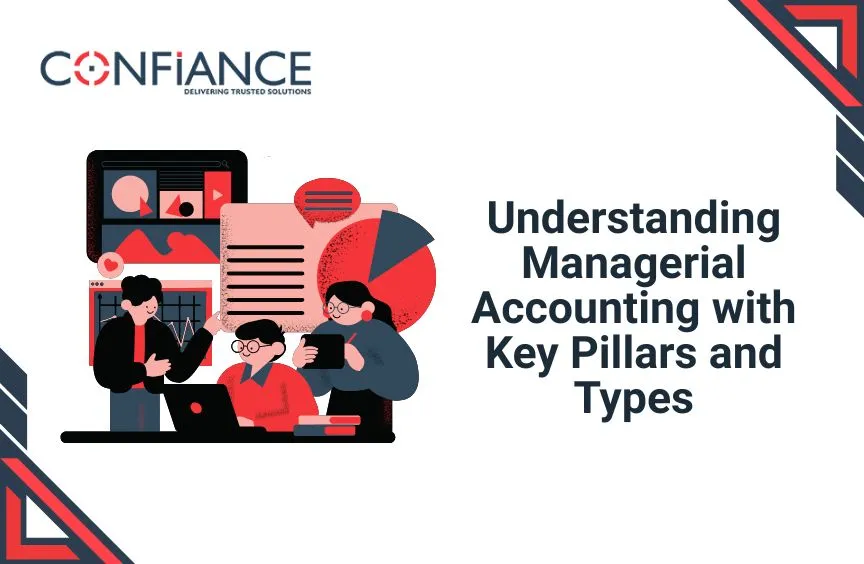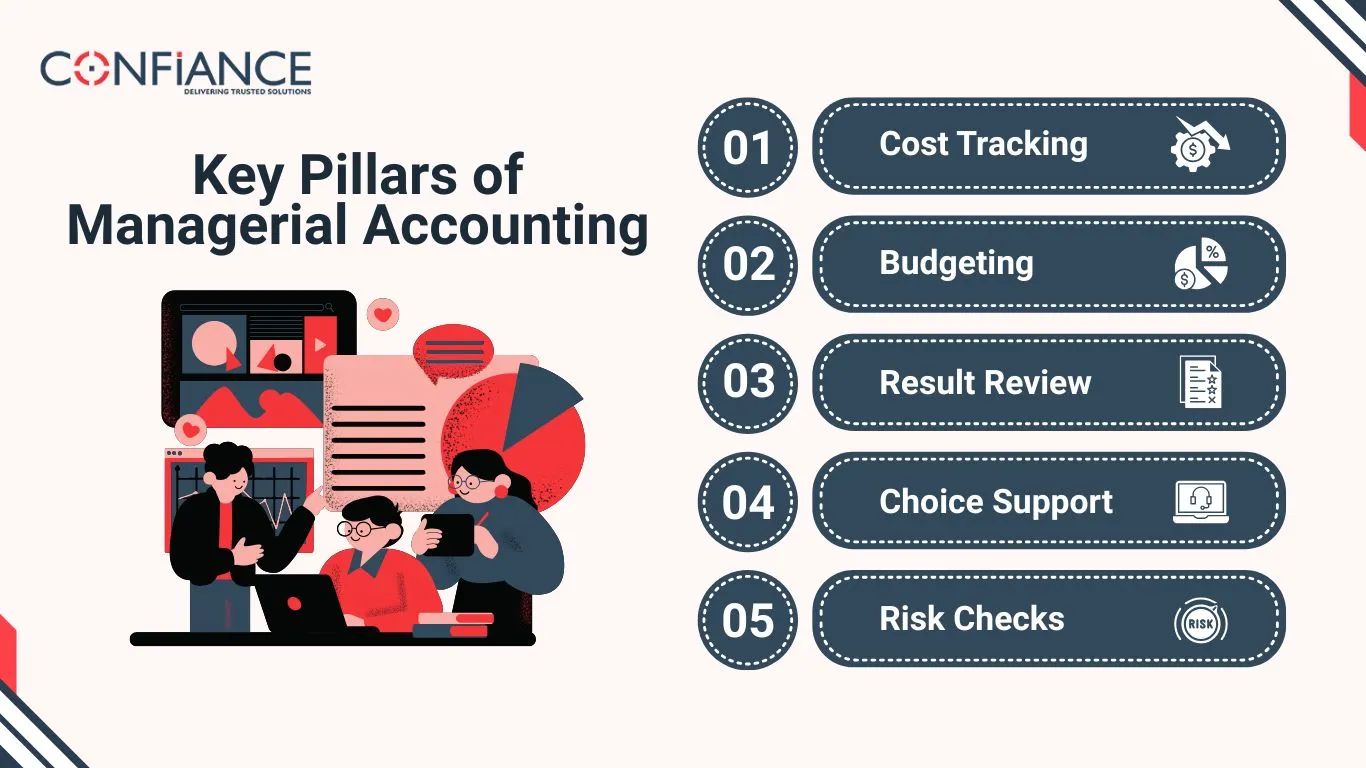
Understanding Managerial Accounting with Key Pillars and Types
Managerial accounting helps business owners and managers track money, costs, and performance. It is a tool for making smart choices. With clear numbers, managers can plan better, cut waste, and see where to grow. In this guide, we will explain the key pillars, types, and benefits of management accounting, along with tips for practical use.
What is Managerial Accounting?
Managerial accounting is the use of money records to guide a business. It shows sales, costs, and cash flow. The goal is to give owners and staff the right facts to act fast. Unlike financial accounting, which is made for banks and investors, this type is for people inside the firm.
Why Managerial Accounting Matters
- Helps plan budgets and control spending
- Tracks income, costs, and gains for clear choices
- Points out what parts earn profit or bring loss
- Guides smart plans for growth or for saving funds
Difference from Financial Accounting
- Financial accounting is made for banks, tax staff, and outside groups
- Managerial accounting is for owners and staff in the firm
- It tracks small details of sales, spend, and work
- It helps with daily needs and long-term goals
Key Pillars of Managerial Accounting
Managerial accounting works best when built on clear pillars. These give owners and staff simple, useful facts to guide daily work and long-term plans.
1. Cost Tracking
- Shows money spent on staff, goods, or tasks
- Points out waste and extra spending
- Helps set fair prices and plan profit
- Example: If a team uses too many supplies, costs can be trimmed without slowing work
2. Budgeting
- Plans how money will be used in weeks or months ahead
- Puts limits on spending to stop waste
- Checks planned spend against real spend
- Helps the firm stay ready for busy or slow times
3. Result Review
- Compares real results with goals
- Shows which goods or teams do well
- Points out weak spots that need work
- Simple checks like cost per unit or gain per sale keep tracking clear

4. Choice Support
- Gives facts for hires, buys, or new plans
- Helps pick safe paths with less risk
- Cuts out guesswork for daily and long-term moves
- Keeps the firm steady and on track
5. Risk Checks
- Shows where spending is too high or income is too low
- Warns owners of issues before they grow
- Helps guard cash and plan the use of funds
- Reduces loss and keeps plans safe
Types of Management Accounting
Management accounting is not one method. Businesses use different types to track costs, plan budgets, and guide decisions. Using the right type ensures clear data and smarter choices.
Cost Accounting
- Tracks all costs for products, services, and projects
- Includes direct costs like materials and labor
- Shows indirect costs like rent, electricity, and other overhead
- Helps set product prices and plan budgets
Activity-Based Accounting
- Focuses on tasks that use resources
- Shows which activities cost the most
- Helps managers find ways to save money
- Example: If a task uses too many staff hours, it may need streamlining
Budgetary Accounting
- Compares planned budgets with actual spending
- Shows where money use is too high or too low
- Tracks funds for projects and daily work
- Helps managers adjust and plan for the next period
Standard Costing
- Sets benchmarks for costs
- Compares actual costs to set standards
- Identifies inefficiencies
- Helps improve productivity and reduce waste
Fixed and Variable Cost Analysis
- Variable costs change with production. (Like: materials, Wages)
- Fixed costs remain the same (Like rent, equipment)
- Understanding both helps plan prices and forecast profits
How Managerial Accounting guides Managers in Decision-making
Managerial accounting provides data to help managers in their decisions. Clear numbers guide them in day-to-day actions and long-term plans.
Pricing Decisions
- Tracks costs for each product or service.
- Helps set prices that cover costs and bring profit
- Let's managers adjust prices if costs rise or fall.l
Production Planning
- Shows how much to produce and when
- Helps allocate staff and materials efficiently
- Prevents overproduction or shortages
Investment Choices
- Helps decide if new tools, staff, or projects are affordable
- Shows expected returns and risks
- Supports safe spending of business funds
Cost Control
- Highlights areas with high spending
- Identifies waste or unnecessary expenses
- Helps keep profit levels healthy
Forecasting
- Uses past data to predict future cash flow and costs
- Helps plan for slow months or busy periods
- Guides preparation for growth or new projects
Benefits of Managerial Accounting
Management accounting helps a business run well. It gives clear numbers to guide spending, plan budgets, and grow the business.
Better Planning
Management accounting shows past numbers. Leaders can plan spending, set real goals, and smartly use money.
Cost savings
Tracking all costs shows where money is lost. Leaders can cut extra spending, work better, and make more profit without harm.
Smart Decisions
Clear numbers help leaders choose the best options. For prices, hiring, or buying tools, the right data keeps choices safe and on time.
Track Results
Leaders can see which products, teams, or work do well and which need help. This lets them focus on strong areas and fix weak spots fast.
Lower Risk
By checking costs and cash, leaders can find problems early. Early alerts let them act and lower the risk of loss.
How to Implement Managerial Accounting
Using managerial accounting helps a business get the most from its numbers. Simple steps make it easy to follow and useful.
Start with Clear Records
- Track all costs, sales, and daily work
- Keep receipts, bills, and invoices in orde
- Make sure all records are complete and current
Pick the Right Tools
- Use simple software or spreadsheets to track money
- Choose tools that fit the size and needs of the business
- Avoid tools that are too hard or slow down work
Teach Your Team
- Show staff how to record costs and income the right way
- Explain how to read reports and use the numbers
- Make sure everyone understands the steps
4. Review and Adjust
- Compare planned budgets with what actually happens
- Spot issues early and fix them quickly
- Adjust spending, work, or pricing to stay on track
Common Challenges in Management Accounting
Even with good systems, businesses can face issues that affect decisions. Knowing these challenges helps avoid mistakes.
Missing Records
Incomplete data, like lost invoices or bills, can make the numbers wrong. Managers may make poor choices if records are not complete or updated.
Misreading Reports
Reports can look tricky if managers do not read them well. Basic training helps staff read numbers correctly and make safe choices.
Changing Costs
Prices, wages, and bills can rise or drop fast. Up-to-date records help avoid mistakes in budgets or plans.
Complex Systems
Too many forms or hard-to-use tools can slow daily work. Simple systems are best for small and mid-sized firms.
Limited Staff Knowledge
If staff are not trained, mistakes in recording or reporting can happen. Regular training and guidance help reduce errors.
Impact on Stakeholder Decisions
Management accounting affects more than just owners. It also guides investors, lenders, and staff. Clear numbers help everyone make informed choices.
Investor Confidence
Accurate records show how the business earns and spends money. Investors can see if their money is safe and the business is growing.
Lender Decisions
Banks and lenders review internal accounts before giving loans. Good records make it easier to get funds and better loan terms.
Staff Planning
Managers can decide on wages, benefits, and hiring using internal accounts. This ensures fair allocation of resources across the team.
Supplier Relations
Suppliers can trust timely payments when records are clear. This keeps relationships strong and ensures smooth supply chains.
Management Accounting and Cash Flow
Cash flow is vital for daily operations. Management accounting tracks money coming in and going out, helping managers plan and avoid shortages.
Predict Cash Needs
Looking at records helps predict money needs for bills, wages, and projects. Planning prevents shortages that could stop operations.
Control Spending
Records show which costs are high or unnecessary. Managers can cut waste and save money without hurting output or quality.
Plan for Emergencies
Extra costs can show up at any time. Managers should keep a backup fund to cover them while keeping regular operations running smoothly.
Track Trends
Reviewing cash flow over time shows patterns. Managers can plan for busy or slow periods and make steady, informed decisions.
At Confiance, we help businesses use their financial data to make smart choices. Our services give clear numbers, insights, and support for better planning, cost control, and growth. We handle day-to-day accounting and bookkeeping. This includes tracking income, expenses, and preparing financial statements. With accurate records, managers can see where money goes and make better plans. We use specialized software to turn financial data into simple reports and insights. These show profit trends, costs, and performance. Managers can use this to spot problems, find opportunities, and make better business decisions.
FAQs
- What is managerial accounting?
It tracks money, costs, and operations to help managers make smart choices. - How is it different from financial accounting?
Financial accounting reports to outsiders. Management accounting is for owners and managers to plan and control. - Why use management accounting?
It helps plan budgets, track costs, and improve profits while guiding smart decisions. - Which types are most useful?
Cost accounting, activity-based, and budgetary accounting are widely used. - Can small firms use it?
Yes. Even small firms can track costs, plan spending, and make better choices. - How often should reports be checked?
Check monthly or as needed to spot trends, control costs, and plan. - Does it help with risk?
Yes. Tracking costs and cash helps managers spot issues before they harm profits.
